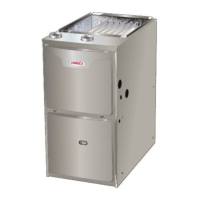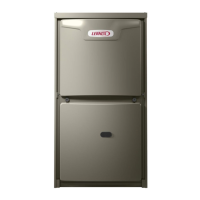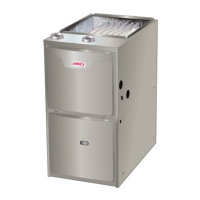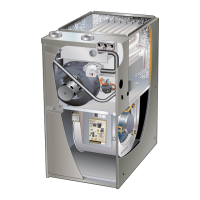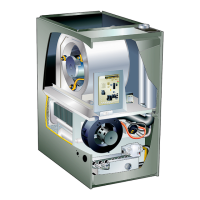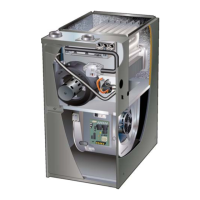Page 46
Testing for Proper Venting and Sucient
Combustion Air for Non-Direct Vent Applications
WARNING
CARBON MONOXIDE POISONING HAZARD!
Failure to follow the steps outlined below for each
appliance connected to the venting system being placed
into operation could result in carbon monoxide poisoning
or death. The following steps shall be followed for each
appliance connected to the venting system being placed
into operation, while all other appliances connected to
the venting system are not in operation.
After the ML196UHE gas furnace has been started, the
following test should be conducted to ensure proper vent-
ing and sucient combustion air has been provided to the
ML196UHE as well as to other gas-red appliances which
are separately vented.
If a ML196UHE furnace replaces a Category I furnace
which was commonly vented with another gas appliance,
the size of the existing vent pipe for that gas appliance
must be checked. Without the heat of the original furnace
ue products, the existing vent pipe is probably oversized
for the single water heater or other appliance. The vent
should be checked for proper draw with the remaining ap-
pliance.
The test should be conducted while all appliances (both
in operation and those not in operation) are connected to
the venting system being tested. If the venting system has
been installed improperly, or if provisions have not been
made for sucient amounts of combustion air, corrections
must be made as outlined in the previous section.
1 - Seal any unused openings in the venting system.
2 - Visually inspect the venting system for proper size and
horizontal pitch. Determine there is no blockage or
restriction, leakage, corrosion, or other deciencies
which could cause an unsafe condition.
3 - To the extent that it is practical, close all building
doors and windows and all doors between the space
in which the appliances connected to the venting
system are located and other spaces of the building.
4 - Close replace dampers.
5 - Turn on clothes dryers and any appliances not
connected to the venting system. Turn on any
exhaus fans, such as range hoods and bathroom
exhausts, so they will operate at maximum speed.
Do not operate a summer exhaust fan.
6 - Follow the lighting instruction to place the appliance
being inspected into operation. Adjust thermostat so
appliance will operate continuously.
7 - Use the ame of match or candle to test for spillage
of ue gases at the draft hood relief opening after 5
minutes of main burner operation.
8 - If improper venting is observed during any of the
above tests, the venting system must be corrected
or sucient combustion/make-up air must be
provided. The venting system should be re-sized
to approach the minimum size as determined by
using the appropriate tables in appendix G in the
current standards of the National Fuel Gas Code
ANSI-Z223.1/NPFA 54 in the U.S.A., and the
appropriate Natural Gas and Propane appliances
venting sizing tables in the current standard of the
CSA-B149 Natural Gas and Propane Installation
Codes in Canada.
9 - After determining that each appliance remaining
connected to the common venting system properly
events when tested as indicated in step 3, return
doors, windows, exhaust fans, replace dampers
and any other gas-burning appliance to their previous
condition of use.
Other Unit Adjustments
Primary Limit.
The primary limit is located on the heating compartment
vestibule panel. This limit is factory set and requires no
adjustment.
Flame Rollout Switches (Two)
These manually reset switches are located in the burner
box.
Pressure Switch
The pressure switch is located in the heating compartment
on the cold end header box. This switch checks for proper
combustion air inducer operation before allowing ignition
trial. The switch is factory-set and must not be adjusted.
Temperature Rise
After the furnace has been started and supply and return
air temperatures have been allowed to stabilize, check the
temperature rise. If necessary, adjust the blower speed to
maintain the temperature rise within the range shown on
the unit nameplate. TABLE 18 on page 56 allowable
heating speeds. Increase the blower speed to decrease
the temperature. Decrease the blower speed to increase
the temperature rise. Failure to adjust the temperature
rise may cause erratic limit operation.
Fan Control
Fan On Delay
The heat fan on time of 30 seconds is not adjustable. The
cool fan on delay is 2 seconds and not adjustable.
Fan O Delay
The heat fan o delay (amount of time that the blower
operates after the heat demand has been satised) may
be adjusted by changing the jumper position across the
ve pins on the integrated control. The unit is shipped with
a factory fan o setting of 90 seconds. The fan o delay
aects comfort and is adjustable to satisfy individual ap-
plications. Adjust the fan o delay to achieve a supply air
temperature between 90° and 110°F at the moment that
the blower is de-energized. Longer o delay settings pro-
vide lower return air temperatures; shorter settings pro-
vide higher return air temperatures. See Figure 62. The
cool fan o delay (amount of time that the blower operates
after the cool demand has been satised) is 45 seconds
and not adjustable.

